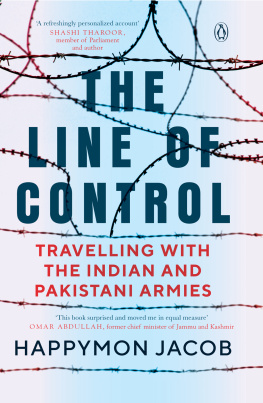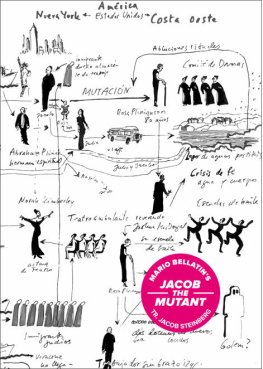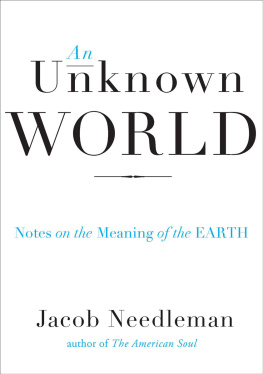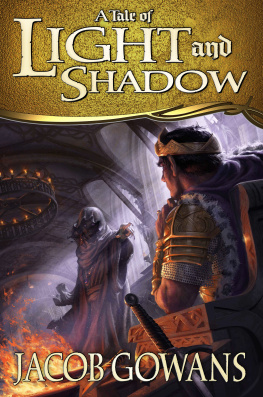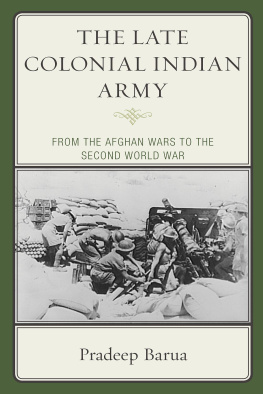Advance Praise for the Book
Happymon Jacobs The Line of Control engagingly decodes the complexity of the Indo-Pak relationship, drawing on a refreshingly personalized account of his visit to the Pakistani side of the Line of Control, complemented by the nuanced analysis that has been a hallmark of this seasoned commentator. An insightful and objective assessment that consciously steers clear of histrionics, this book is a welcome addition to the literature on the subjectDr Shashi Tharoor, member of Parliament, Lok Sabha, from Thiruvananthapuram and chairman of the Parliamentary Standing Committee on External Affairs
I started The Line of Control expecting a dry academic book but what I got was anything but that. Happymon brings alive the conflict and tensions between India and Pakistan by focusing on the human storiesthe soldiers, the officers, the politicians, the people of the two countries are all part of the landscape. The Line of Control is about so much more than the wires, mines and gadgets that divide, its about the people and how the reality of this line affects lives every single day. This book surprised me and moved me in equal measure. I for one am glad that Happymon went through the trouble of writing itOmar Abdullah, former chief minister, Jammu and Kashmir
This book reminds me of my time on the Line of Control. As the brigade major of 4 AK brigade, I dealt with the ceasefire violations in the southern sector for three yearsand that too soon after the 71 War. I am therefore familiar with all these grounds: cattle grazers, calls of duty and breaking of monotonies. Most importantly, however, we had to ensure that the trauma of the lost war did not suppress the spirit of our troops. Of course, some violations had to be initiated by us precisely to address that issue. In the meantime, it has gotten worse after the uprising of the early 1990s. What is significant in this study is that Professor Jacob humanizes this spectacle. Yes, political or psychological factors guide the policy, the perpetrators may exchange bonhomie during the flag meetings, to then move on to more peaceful placesbut there is no end to the sufferings of the people. No wonder that the faith healers are their ultimate hopeAsad Durrani, former director general of Military Intelligence and chief of the Inter-Services Intelligence, Pakistan Army
When you have a worthy academic with such a wealth of experience in dealing with Jammu and Kashmir through interaction with both sides to the conflict, he can make that experience extremely useful by making serious attempts at understanding the nuts and bolts on ground. That intent took Happymon Jacob to the turbulent environment of the Line of Control (LoC), not only on the Indian side but also to the Pakistani side across the LoC. This outstanding book is a product of this rare endeavour to blend the academic and intellectual understanding of the complex LoC-related issues such as infiltration and cross-border firing, with practical aspects of soldiering at one of the most dangerous places on earth. A must-read for every scholar warrior in India, for deeper understanding of Pakistan and its ways in Jammu and KashmirLieutenant General (retd) Syed Ata Hasnain, former general officer commanding 15 Corps and military secretary, Indian Army
To Siddhartha, for asking me what a B-O-R-D-E-R is and looking so bewildered when I tried explaining it to you.
Dont lose that bewilderment!
Prologue
December 2017
December 2017 wasnt remarkable for any particular reason, except perhaps to me. India and Pakistan played host to the usual milieu of relentless cross-border firing and selectively leaked secret meetings between their national security advisers (NSAs)not unique by any standard. This was the age of violence, both within and between the two South Asian rivals. It wasnt anything special or distinctly worrisome: the two countries had gotten used to it by then. Most people referred to it with routine indifference, if they referred to it at all. Others vowed revenge, but from within the confines of television studios, of course. Young men in uniform died guarding the citizens of India, and Pakistanthose with inflated national egos and those without.
In reality, 2017 was the bloodiest year since the IndiaPakistan ceasefire agreement came into effect in November 2003. Several dozens of Indian and Pakistani soldiers and civilians were killed and even more injured on the Line of Control (LoC). Ceasefire violations (CFVs) spiked alarmingly. Since 2014 (till the end of 2017), when the Hindu nationalist leader Narendra Modi led the Bharatiya Janata Party (BJP) to power in New Delhi, India reported 2408 ceasefire violations; and Pakistan reported 2915 violations. According to news reports, the Indian Army killed 138 Pakistani soldiers in 2017, and lost around twenty-eight of its own. Young men continued to be mobilized by the two sides to be sent to the LoC, to kill and get killed.
The media got their drama as the two NSAs of Pakistan and India, Nasser Khan Janjua and Ajit Kumar Doval, men who had the ear of their respective prime ministers, scheduled a secret meeting at an undisclosed location in Bangkok on 26 December 2017. The retired general and the former spymaster had made it a habit to adjourn to Bangkok when things went south between their countries. The media houses loved the spectacle and the suspense. The meeting was covered for its theatre, not for its outcomes, of which there were none. Most of the 24X7 television channels had forgotten to ask hard questions. Why would they when nationalistic drama demonstrably raises Television Rating Points (TRPs)? To be fair, the nightly guardians of our national interest did ask probing questions of the hapless Opposition, most of whom ran for cover when the combined force of the mainstream media and the right-wing government took them to task.
The shelling, firing and killing continued apace. In the first three months of 2018 alone, Pakistan reported 900 violations and India 633. That is, India fired 267 times more than Pakistan.
Whats the big deal about 633 violations? you might wonder. Each violation could comprise hundreds of thousands of shots from weapons ranging from AK-47s to heavy pieces of military artillery such as 130-mm mortar guns in an area of 2050 square kilometres over a twenty-four-hour period. Statistics wont and, as a matter of fact, cant ascertain how many shots were actually fired. No one knows those numbers for sure. Not that it mattered. You dont count the raindrops when it pours.
The violence on the border had become routine. Some celebrated it; some ignored it as minor incidents; and some used it to make electoral gains. The families of those killed on the line often refused to condemn the violence by their own side; and if at all they did, no one reported it. Even faint suggestions of standing down in times of national catharsis could lose you the much-needed eyeballs, and commercial advertisements. What then stood out was a disturbing consensus on retaliation, on sorting out the adversary. This was a classic case of manufacturing consent.

